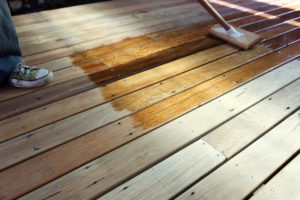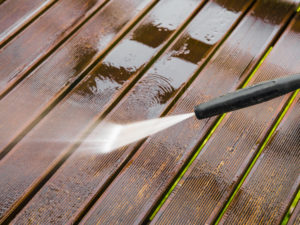How To Oil A Deck
By Dave KileA deck is definitely a convenient addition to your outdoor area. It’s an area where you spend a lot of time with family and friends, whether you simply want to hang out or plan a barbecue. Over time, however, you may find that the deck starts to fade or show signs of damage. A deteriorating deck can be unfortunate, as you do not want to replace your entire deck. Maintenance can significantly reduce these issues from developing, including using deck oil. While it may seem tedious at first, the cost of building a timber deck is undoubtedly much higher than implementing a proper maintenance plan for your current one.
This post will take a closer look at the procedure you should use to oil your deck. We will also consider the specific steps to take and provide an overview of the potential benefits you can expect from these procedures.
Tools And Materials Needed For Oiling The Deck
Several types of timber require regular oiling, whether you have a hardwood deck or another type of wooden material for your deck. If you want to clean the deck and apply timber oil as part of your deck maintenance strategy, it is important to start by ensuring you have the right equipment and materials.
The first thing to consider is the type of oil that you will use. You need to ensure you use high-quality oil, as this can help to prevent the need for a recoat if the oil fails to produce adequate UV protection. If you want to implement a decking stain system, consider this before applying the layer of oil. The best decking oil can help to create a protective layer over stains and other elements that you add to improve the appearance of your deck.
Apart from the oil, you also need a few tools to help you clean the deck and apply multiple layers of the decking oil. A pressure washer connected to your garden hose works well for cleaning the deck initially. If you have old oil on the deck, then a stiff-bristled decking brush can help remove it before applying a fresh coat of oil onto your deck. Finally, it would be best if you got a firm paintbrush for the oil application process. A paintbrush with large bristles can make the process faster and easier while applying the decking oil.
Steps To Deck Oiling
 If you wish to apply oil to a deck yourself, there are only a few steps to follow. However, it is important to ensure you follow these steps properly to ensure the deck looks great the first time.
If you wish to apply oil to a deck yourself, there are only a few steps to follow. However, it is important to ensure you follow these steps properly to ensure the deck looks great the first time.
Cleaning And Preparing Your Deck
First, you need a clean timber deck to work with, so use a broom to remove any debris that you find on the surface. Next is a pressure washer, which can help remove some of the stuck debris that your broom cannot eliminate. A clean deck is all you need for the initial preparation, except for cases where you have an existing layer of oil that you wish to remove first. In this case, you should use a sander to remove the oil before you decide to apply a new coat.

Application
The application process is critical and will significantly impact the overall results. You can use a paintbrush to apply the oil to your deck. There are also special deck brushes that you can use, often alongside a pole extension, to give you a better reach toward the timber. Use continuous strokes and ensure you cover every part of the deck, including any small crevices.
Allow To Dry
Once you have applied the oil, allowing it to dry after every coat is essential. You may need to apply two or three coats to the deck to ensure the oil provides adequate protection for the timber. Wait about four hours between every coat before applying the next oil layer. Four hours is generally enough time for the oil to soak into the timber and dry thoroughly.
What Does Decking Oil Do?
Decking oil provides numerous benefits for a deck that is situated outdoors. It adds a UV protection element to the deck, which helps to reduce the risk of fading and other problems that UV exposure can cause. Decking oil also helps to keep your deck looking good and even helps to protect deck joists. In addition to these factors, decking oil also helps extend the lifespan of specific treatments you add to your deck, such as after a staining procedure.
When To Oil Your New Deck?
Once you have worked with a timber supplier and have your new timber deck, you may feel tempted to oil a deck right away. Unfortunately, this is usually not a good idea. Instead, it is important to allow the deck to wither slightly due to exposure to natural elements, such as wind and UV rays, for a short time. It is a good idea to wait around five to six weeks before you decide to apply the oil to your new deck.
What Are The Drying Times For Decking Oil?
You usually need to apply multiple layers of oil to your deck. This is why you should understand how long it takes for the first coat to dry. In most cases, the oil takes around four hours to dry properly. Therefore, you should only apply a second or third coat after waiting for the first layer to dry completely.
What Is The Best Oil To Use?
Take a look at the ingredients these oils use to get an idea about which is right for your deck. The specific type of timber you use plays a role in the best oil you should use. A transparent oil is generally best if you do not wish to adjust the colour or create a stain on your deck.
Types Of Timber That Do Not Need Oiling
Most people will prefer the use of hardwood materials in the construction of a timber deck. However, with most types of hardwood timber, oiling does produce numerous benefits, as various types of timber can fade or swell up over time due to excessive weather exposure.
Protect Your Deck
Decking oil can help to provide a more efficient level of protection against UV rays, rain, and other outdoor weather elements. However, when you use timber oil for the first time, you may feel like you need more clarification about the specific procedures to follow.
Deck maintenance can be easy and should become part of your home improvement project. We shared a simple three-step system that you can use to keep your deck clean and in good condition over a long time period.